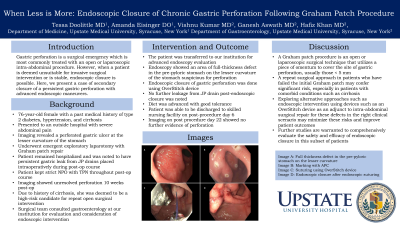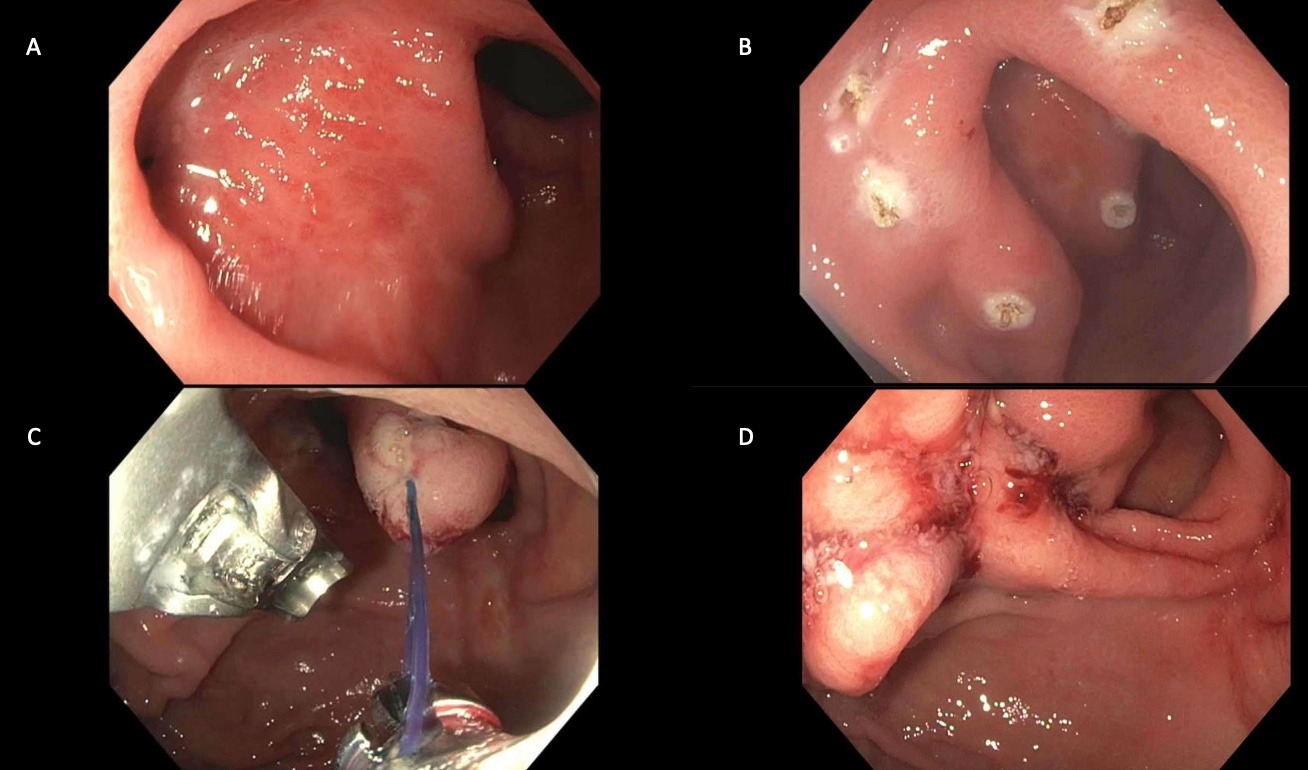Monday Poster Session
Category: Interventional Endoscopy
P2328 - When Less Is More: Endoscopic Closure of Chronic Gastric Perforation Following Graham Patch Procedure
Monday, October 23, 2023
10:30 AM - 4:15 PM PT
Location: Exhibit Hall

Has Audio
- TD
Tessa Doolittle, MD
SUNY Upstate Medical University
Syracuse, NY
Presenting Author(s)
Award: Presidential Poster Award
Tessa Doolittle, MD1, Amanda Eisinger, DO1, Vishnu Kumar, MBBS2, Ganesh Aswath, MD3, Hafiz M. Khan, MD1
1SUNY Upstate Medical University, Syracuse, NY; 2SUNY Upstate, Syracuse, NY; 3Upstate University Hospital, Syracuse, NY
Introduction: Management of perforated gastric ulcers consists of open or laparoscopic intra-abdominal surgical repair, often with oversewing of the site of perforation with a Graham patch or primary closure. The patient typically would need further surgery if the Graham patch failed. With advancements in interventional endoscopy, endoscopic closure may be offered to patients for the management of gastrointestinal tract perforations either as an adjunct or as a primary modality in the right clinical setting. We present a case of a chronic gastric perforation that was repaired with the OverStitch system in a patient who had previously undergone an exploratory laparotomy procedure with Graham patch placement.
Case Description/Methods: A 76-year-old female with a past medical history of type 2 diabetes, hypertension, cirrhosis, and obesity, presented with severe abdominal pain. Imaging revealed a perforated gastric ulcer at the lesser curvature, and she underwent emergent exploratory laparotomy with Graham patch repair. Following surgical intervention, she remained hospitalized and was noted to have persistent gastric leak from JP drains placed intraoperatively. She was deemed to be a high-risk candidate for repeat open surgical procedures in the setting of cirrhosis and therefore consultation for endoscopic intervention was pursued by the surgical team. An endoscopic evaluation revealed an n area of full-thickness defect in the pre-pyloric stomach on the lesser curvature of the stomach suspicious for perforation. After marking the site with APC, the Overstitch device utilizing 2.0 polypropylene full-thickness sutures were used to close the perforation. No further leakage from JP drain post-endoscopic closure was noticed
Discussion: A Graham patch procedure is an open or laparoscopic surgical technique that utilizes a piece of omentum to cover the site of gastric perforation < 5 mm. A repeat surgical approach in patients who have failed the initial graham patch may confer significant risk, especially in patients with comorbid conditions such as cirrhosis. Exploring alternative approaches such as endoscopic intervention using devices such as the Apollo Overstitch as an adjunct to repair these defects in the right clinical scenario may minimize these risks and improve patient outcomes. Further studies are warranted to comprehensively evaluate the safety and efficacy of endoscopic closure in this subset of patients.

Disclosures:
Tessa Doolittle, MD1, Amanda Eisinger, DO1, Vishnu Kumar, MBBS2, Ganesh Aswath, MD3, Hafiz M. Khan, MD1. P2328 - When Less Is More: Endoscopic Closure of Chronic Gastric Perforation Following Graham Patch Procedure, ACG 2023 Annual Scientific Meeting Abstracts. Vancouver, BC, Canada: American College of Gastroenterology.
Tessa Doolittle, MD1, Amanda Eisinger, DO1, Vishnu Kumar, MBBS2, Ganesh Aswath, MD3, Hafiz M. Khan, MD1
1SUNY Upstate Medical University, Syracuse, NY; 2SUNY Upstate, Syracuse, NY; 3Upstate University Hospital, Syracuse, NY
Introduction: Management of perforated gastric ulcers consists of open or laparoscopic intra-abdominal surgical repair, often with oversewing of the site of perforation with a Graham patch or primary closure. The patient typically would need further surgery if the Graham patch failed. With advancements in interventional endoscopy, endoscopic closure may be offered to patients for the management of gastrointestinal tract perforations either as an adjunct or as a primary modality in the right clinical setting. We present a case of a chronic gastric perforation that was repaired with the OverStitch system in a patient who had previously undergone an exploratory laparotomy procedure with Graham patch placement.
Case Description/Methods: A 76-year-old female with a past medical history of type 2 diabetes, hypertension, cirrhosis, and obesity, presented with severe abdominal pain. Imaging revealed a perforated gastric ulcer at the lesser curvature, and she underwent emergent exploratory laparotomy with Graham patch repair. Following surgical intervention, she remained hospitalized and was noted to have persistent gastric leak from JP drains placed intraoperatively. She was deemed to be a high-risk candidate for repeat open surgical procedures in the setting of cirrhosis and therefore consultation for endoscopic intervention was pursued by the surgical team. An endoscopic evaluation revealed an n area of full-thickness defect in the pre-pyloric stomach on the lesser curvature of the stomach suspicious for perforation. After marking the site with APC, the Overstitch device utilizing 2.0 polypropylene full-thickness sutures were used to close the perforation. No further leakage from JP drain post-endoscopic closure was noticed
Discussion: A Graham patch procedure is an open or laparoscopic surgical technique that utilizes a piece of omentum to cover the site of gastric perforation < 5 mm. A repeat surgical approach in patients who have failed the initial graham patch may confer significant risk, especially in patients with comorbid conditions such as cirrhosis. Exploring alternative approaches such as endoscopic intervention using devices such as the Apollo Overstitch as an adjunct to repair these defects in the right clinical scenario may minimize these risks and improve patient outcomes. Further studies are warranted to comprehensively evaluate the safety and efficacy of endoscopic closure in this subset of patients.

Figure: Image A: Full thickness defect in the pre-pyloric stomach on the lesser curvature
Image B: Marking with APC
Image C: Suturing using Overstitch device
Image D: Endoscopic closure after endoscopic suturing
Image B: Marking with APC
Image C: Suturing using Overstitch device
Image D: Endoscopic closure after endoscopic suturing
Disclosures:
Tessa Doolittle indicated no relevant financial relationships.
Amanda Eisinger indicated no relevant financial relationships.
Vishnu Kumar indicated no relevant financial relationships.
Ganesh Aswath indicated no relevant financial relationships.
Hafiz Khan indicated no relevant financial relationships.
Tessa Doolittle, MD1, Amanda Eisinger, DO1, Vishnu Kumar, MBBS2, Ganesh Aswath, MD3, Hafiz M. Khan, MD1. P2328 - When Less Is More: Endoscopic Closure of Chronic Gastric Perforation Following Graham Patch Procedure, ACG 2023 Annual Scientific Meeting Abstracts. Vancouver, BC, Canada: American College of Gastroenterology.

